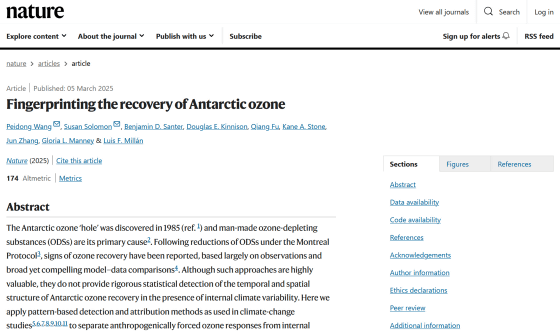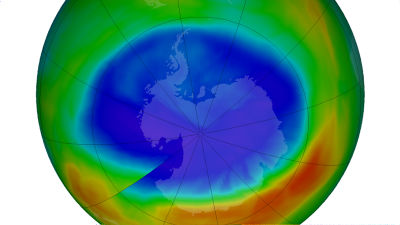Research results show that the Antarctic ozone hole has shrunk due to 'human efforts to reduce CFC emissions'

The layer in the Earth's atmosphere with a particularly high
Fingerprinting the recovery of Antarctic ozone | Nature
https://www.nature.com/articles/s41586-025-08640-9

Study: The ozone hole is healing, thanks to global reduction of CFCs | MIT News | Massachusetts Institute of Technology
https://news.mit.edu/2025/study-healing-ozone-hole-global-reduction-cfcs-0305
The 'ozone hole,' a phenomenon in which ozone levels over Antarctica decrease during the Southern Hemisphere's spring period from September to December and appear as if a hole has opened up, was reported in a paper in 1985. The main cause of this was thought to be chlorofluorocarbons (CFCs), which were once widely used as refrigerants in air conditioners and refrigerators.
CFCs are chemically stable, and when released into the atmosphere, they reach the stratosphere almost completely unbroken. When decomposed by ultraviolet light, they release chlorine atoms. It is known that these chlorine atoms act as catalysts to initiate a chain reaction that breaks down ozone.
The Montreal Protocol , adopted in 1987, regulated the manufacture, consumption, and trade of CFCs and other chemicals that could damage the ozone layer. As a result, the ozone hole has been shrinking year by year, and in 2018 it was reported that the Antarctic ozone hole was the smallest since 1988. However, it was unclear whether this recovery of the ozone layer was due to international efforts to reduce emissions of CFCs and other chemicals, or to climate change such as global warming.
NASA announces that the ozone hole in Antarctica is the smallest since 1988, and 'global warming' is also behind it - GIGAZINE

So a research team from the Massachusetts Institute of Technology conducted a quantitative study to determine the cause of the recovery of the Antarctic ozone layer. In the study, an analysis was conducted to separate natural meteorological noise from other factors using a method called 'fingerprinting' proposed by Klaus Hasselmann , who won the Nobel Prize in Physics in 2021.
The team first generated multiple simulations of the same Earth's atmosphere with different 'parallel world' starting conditions, one in which greenhouse gas and ozone-depleting emissions remained constant and only climate change occurred, one in which greenhouse gas emissions only increased, and one in which only a decrease in ozone-depleting substances occurred.
They then compared the results of various simulations to see how the Antarctic ozone layer changes with season and altitude, and combined these with satellite observations of the Antarctic ozone hole since 2005 to look for 'fingerprints' of human activity on the ozone layer.
The analysis confirmed that it was highly likely that the reduction in anthropogenic emissions of ozone-depleting substances caused the recovery of the ozone layer in Antarctica. The fingerprint was particularly strong in 2018, and it was possible to say with 95% confidence that the recovery of the ozone layer was due to the reduction in emissions of ozone-depleting substances.
'What we can learn from the ozone study is that different countries can quickly comply with these treaties and reduce their emissions,' said Peidong Wang, lead author of the paper and a graduate student in the Department of Earth, Atmospheric and Planetary Sciences at MIT. He argued that the results of this study suggest that people can work together to solve environmental problems.

Related Posts:
in Science, Posted by log1h_ik






